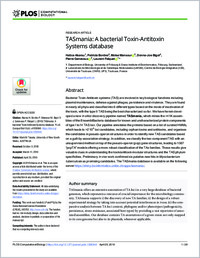TASmania: A bacterial Toxin-Antitoxin Systems database
- Akarsu, Hatice Department of Biology, University of Fribourg - Swiss Institute of Bioinformatics, Fribourg, Switzerland
- Bordes, Patricia Laboratoire de Microbiologie et de Génétique Moléculaires (LMGM), Centre de Biologie Intégrative (CBI), Université de Toulouse, CNRS, UPS, Toulouse, France
- Mansour, Moise Laboratoire de Microbiologie et de Génétique Moléculaires (LMGM), Centre de Biologie Intégrative (CBI), Université de Toulouse, CNRS, UPS, Toulouse, France
- Bigot, Donna-Joe Laboratoire de Microbiologie et de Génétique Moléculaires (LMGM), Centre de Biologie Intégrative (CBI), Université de Toulouse, CNRS, UPS, Toulouse, France
- Genevaux, Pierre Laboratoire de Microbiologie et de Génétique Moléculaires (LMGM), Centre de Biologie Intégrative (CBI), Université de Toulouse, CNRS, UPS, Toulouse, France
- Falquet, Laurent Department of Biology, University of Fribourg - Swiss Institute of Bioinformatics, Fribourg, Switzerland
- 25.04.2019
Published in:
- PLOS Computational Biology. - 2019, vol. 15, no. 4, p. e1006946
English
Bacterial Toxin-Antitoxin systems (TAS) are involved in key biological functions including plasmid maintenance, defense against phages, persistence and virulence. They are found in nearly all phyla and classified into 6 different types based on the mode of inactivation of the toxin, with the type II TAS being the best characterized so far. We have herein developed a new in silico discovery pipeline named TASmania, which mines the >41K assemblies of the EnsemblBacteria database for known and uncharacterized protein components of type I to IV TAS loci. Our pipeline annotates the proteins based on a list of curated HMMs, which leads to >2.106 loci candidates, including orphan toxins and antitoxins, and organises the candidates in pseudo- operon structures in order to identify new TAS candidates based on a guilt-by- association strategy. In addition, we classify the two-component TAS with an unsupervised method on top of the pseudo-operon (pop) gene structures, leading to 1567 “popTA” models offering a more robust classification of the TAs families. These results give valuable clues in understanding the toxin/antitoxin modular structures and the TAS phylum specificities. Preliminary in vivo work confirmed six putative new hits in Mycobacterium tuberculosis as promising candidates. The TASmania database is available on the following server https://shiny.bioinformatics.unibe.ch/apps/tasmania/.
- Faculty
- Faculté des sciences et de médecine
- Department
- Département de Biologie
- Language
-
- English
- Classification
- Biological sciences
- License
-
License undefined
- Identifiers
-
- RERO DOC 326708
- DOI 10.1371/journal.pcbi.1006946
- Persistent URL
- https://folia.unifr.ch/unifr/documents/307892
Statistics
Document views: 123
File downloads:
- pdf: 249
